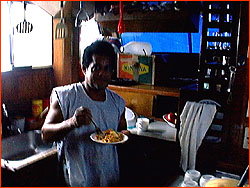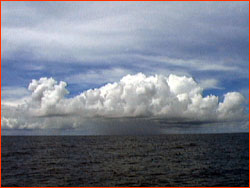 |
 |

|
Editor's Note: The following dispatch was written on February 18, but received on February 23, due to communications difficulties. For more on that subject, see Transmitting from a Fish Bucket.In the Core of El Niño February 18, 1998 By Mark Hoover previous | next At this moment we are steaming out to sea from the Galapagos (believe me, "steaming" is the right word), to meet NOAA's research and service vessel Ka'imimoana at 0 degrees latitude, 95 degrees west longitude. That's 30 hours of open blue Pacific in the Orca. Take another look at the picture of the Orca, and tell me if you'd take it across Walden Pond. When first we espied it in Baltra Harbor last weekend, we were all joking about it. Josh Martin, the cameraman, pointed at it as our bus pulled up to the dock. "Hey guys, check out the low rider. Probably rented it for a week to some British birdwatchers. What a tub." Of course, we all were certain that the smart cabin cruiser moored behind it was our boat, with the tinted windows, rakishly angled bow, and teak decks. And then came the reality check. After some earnest exchange about how it's actually an advantage to ride low (as Josh put it, "you know, like a Russian trawler—those things never sink..."), we resigned ourselves to our fates and loaded the gear. You see, it turns out there's a solar eclipse in the Galapagos next week, so the best boats had been snapped up for months. Or so our suddenly nervous director kept saying over and over to anyone who would listen. I don't think Mike McPhaden, our resident scientist, has complained about anything twice in his life. He's a deeply curious and observant man of naturally good spirits, and someone whose mere presence stimulates both the desire to know more about the world, and a feeling of bonhomie and adventure. Mike had pulled out an official-looking check-off form as we boarded the Orca. Noticing me noticing his list, he explained that his boss at NOAA, ever mindful of the safety of his top scientist, had instructed Mike to make sure the Orca was seaworthy, according to NOAA standards. "Well, Mike, did you get through the checklist?" I asked. He paused, folded the paper in quarters, and put it in his pocket. "Plenty of life preservers. In fact, two extra," he finally said. And that was that. Way back on the horizon, I can still see the top of one of Isla Isabella's volcanoes, but already we are beyond the wave shadow of the islands, and the seas are starting to pitch as only big water can, with the winds pushing the swells higher and higher. Looking sideways, I see water, not sky, as the boat descends into a trough, and then all sky as the boat climbs another swell. I hope that our relative good fortune with weather so far holds, for I don't see how the Orca can survive in stormy seas, despite the excellence of our Ecuadorian crew. I joke to Fernando, our naturalist, that at least one would not perish of hypothermia in these waters. "Oh no, not at all. Around here, the sharks would bite you in half before your hair got wet."  I've got other worries, unfortunately. Bad computer juju. That's why I'm
writing this longhand right now, while I dry out some parts of my PowerBook
that got wet, in a pan sitting next to me. As the boat rolls in the waves, its
stern clears the water, and exhaust from the diesel motors is sucked back over
the afterdeck. Carlos, the diminutive chef d'hôtel, has as usual whipped
up something amazing in his four by three foot galley (have you seen the movie
Amistad? Carlos wept for two days when he saw it...over the sinful display of
luxuries he would never enjoy). But despite Carlos' best efforts, between the
fumes and the pitching, I don't think there will be many people at the dinner
table tonight.
I've got other worries, unfortunately. Bad computer juju. That's why I'm
writing this longhand right now, while I dry out some parts of my PowerBook
that got wet, in a pan sitting next to me. As the boat rolls in the waves, its
stern clears the water, and exhaust from the diesel motors is sucked back over
the afterdeck. Carlos, the diminutive chef d'hôtel, has as usual whipped
up something amazing in his four by three foot galley (have you seen the movie
Amistad? Carlos wept for two days when he saw it...over the sinful display of
luxuries he would never enjoy). But despite Carlos' best efforts, between the
fumes and the pitching, I don't think there will be many people at the dinner
table tonight. Okay, I couldn't take that diesel smoke anymore, so now I'm up on the foredeck. The sense of space in the open ocean is breathtaking. Overhead, towering formations of marine clouds move through the sky. Scanning the horizon, I spot no fewer than six storm cells arrayed around us, marked by clouds remarkably similar to the mushroom clouds of an atomic explosion. Here in the hot and saturated air at the center of El Niño, the ocean is throwing huge amounts of moisture and energy into the atmosphere, and each of these cells marks a local evaporation/precipitation system 20 or 30 miles across. You can see a great number of these convection cells over the warm seawater of the tropical Pacific in the Global Weather Machine section of this Web site.  In each cell, evaporated by the sun's heat, moisture ascends in columns of
rising warm air, and begins to condense as it rises higher and higher, forming
the characteristic mushroom-like cloud. Eventually, the condensation becomes
outright precipitation, evident in the sheets of rain I can see beneath the
clouds. Sometimes the cells become so numerous they merge, and then the whole
area is socked in for days of rain that would make Noah nervous.
In each cell, evaporated by the sun's heat, moisture ascends in columns of
rising warm air, and begins to condense as it rises higher and higher, forming
the characteristic mushroom-like cloud. Eventually, the condensation becomes
outright precipitation, evident in the sheets of rain I can see beneath the
clouds. Sometimes the cells become so numerous they merge, and then the whole
area is socked in for days of rain that would make Noah nervous.When water evaporates, it absorbs heat. When water condenses and falls as rain, it throws off the heat it absorbed (scientists call this latent heat release). This heat energy now becomes a driving force in the upper level winds, energizing them. This is the mechanism El Niño principally uses to pump energy from the ocean to the higher parts of the atmosphere. On a large scale the effect can be awesome, culminating in massive hurricanes, as we saw late last summer and fall in the eastern Pacific, or in strongly-developed winter cyclones fed by tropical moisture, as we are seeing right now along the west coast of North America. What is it like to be in the core of El Niño? It is to be aware with your own skin that the sea is febrile, that the amount of heat involved is colossal, and that this heat is being used to pump unimaginable quantities of water into the atmosphere. What goes up must come down, as it has recently with a vengeance in Peru and elsewhere. But the wet heat, more than anything, is the principal impression. This is the boiler room of a huge weather machine. Tomorrow when we meet the Ka'imimoana, we'll learn how scientists use a thermometer 4,000 miles long to monitor this fever of the ocean. previous dispatch | next dispatch | table of contents Anatomy of El Niño | Chasing El Niño | El Niño's Reach Dispatches | Resources | Mail | Site Map | El Niño Home Editor's Picks | Previous Sites | Join Us/E-mail | TV/Web Schedule About NOVA | Teachers | Site Map | Shop | Jobs | Search | To print PBS Online | NOVA Online | WGBH © | Updated November 2000 |